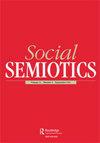Monuments to Lenin in the post-Soviet cultural landscape
IF 1.6
2区 文学
Q2 COMMUNICATION
引用次数: 3
Abstract
ABSTRACT Landscape semiotics can be explored by focusing on Vladimir Lenin, whose likeness once graced more than 14,000 toponyms, museums, statues and monuments. During the Soviet period, Lenin monuments reflected a symbolic language linking communist power and ideology to particular sculptural characteristics. After 1991, the significance of Lenin statues took multiple paths of evolution in what Lotman would call “explosion.” Depending on the geographical and political context, Lenin’s statues took on different sorts of “afterlife.” They were variously: (a) preserved and left in place to symbolize the legitimacy of post-Soviet elites, (b) taken for granted but permitted to deteriorate, (c) removed, relocated or destroyed to indicate the end of Soviet occupation, and (d) captured and reworked for use in place promotion and capitalist marketing. These various semiotic trajectories demonstrate a Lotmanian “explosion,” evident in the post-Soviet landscapes of Russia, the former Soviet Republics, and the West.后苏联文化景观中的列宁纪念碑
景观符号学可以通过关注弗拉基米尔·列宁来探索,他的肖像曾经为超过14,000个地名、博物馆、雕像和纪念碑增添光彩。在苏联时期,列宁纪念碑反映了一种象征语言,将共产主义权力和意识形态与特定的雕塑特征联系起来。1991年之后,列宁雕像的重要性在洛特曼所说的“爆炸”中经历了多种演变路径。根据地理和政治背景的不同,列宁的雕像呈现出不同的“来世”。它们有多种方式:(a)保存并留在原地,象征后苏联精英的合法性;(b)被视为理所当然,但允许恶化;(c)被移除、重新安置或摧毁,表明苏联占领的结束;(d)被捕获并重新制作,用于当地的宣传和资本主义营销。这些不同的符号学轨迹展示了一种洛特曼式的“爆炸”,在苏联解体后的俄罗斯、前苏联加盟共和国和西方都很明显。
本文章由计算机程序翻译,如有差异,请以英文原文为准。
求助全文
约1分钟内获得全文
求助全文

 求助内容:
求助内容: 应助结果提醒方式:
应助结果提醒方式:


